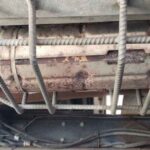Jump-starting a car with jumper cables is a simple process that can get you back on the road quickly. First ensure both cars are safely parked and the engines are off. Next connect the jumper cables correctly to avoid any sparks or damage. Start the working vehicle and let it run for a few minutes. Finally, attempt to start the dead car and remove the cables in the reverse order.
It is a useful skill to know in case your car battery dies. Follow these easy steps to jump-start your car safely. Make sure to connect the cables in the right sequence and start the functioning vehicle first. This method can save you from calling for roadside assistance. Always remember to handle the cables carefully and follow safety instructions.
Safety First: Essential Precautions Before You Start
Safety first is crucial before jumping a car. Check both vehicles to ensure they are off and parked safely.
Ventilation
- Ensure you are in a well-ventilated area.
- Avoid inhaling any harmful fumes.
Protective Gear
- Wear gloves and goggles for safety.
- Use appropriate clothing to protect against spills or sparks.
Equipment Check
- Inspect all equipment for damage before use.
- Replace any faulty or worn-out parts.
Manufacturer’s Instructions
- Read the instructions carefully.
- Follow all safety guidelines provided.
Flammable Materials
- Keep flammable materials away from your work area.
- Store them safely to prevent accidents.
Safety Distance
- Keep children and pets away from the work area.
- Ensure a clear and safe environment.
Always connect the jumper cables in the correct order to avoid sparks. Wear protective gloves and glasses to stay safe during the process.
Gathering the Right Equipment for a Successful Jump
To jump-start your car gather the right equipment first. You’ll need a set of jumper cables and another vehicle with a charged battery. Make sure the cables are in good condition and long enough to reach both cars. Also check that the other vehicle is running smoothly. Having these items ready ensures a successful jump.
Ensure you have all necessary equipment before starting the jump. Jumper cables and a working car battery are essential. Inspect the cables for any damage and make sure they are long enough. A functional second vehicle will help you get your car running again. Proper preparation makes the jump start process easier and safer.
Identifying the Battery Terminals: Positive and Negative
Positive
First locate the positive terminal on the battery. It is usually marked with a plus sign (+). The positive terminal may also have a red cover or cable. Always connect the red jumper cable to this terminal first. This step is crucial for a successful jump-start.
Negative
Next find the negative terminal on the battery. It is marked with a minus sign (-) and may have a black cover or cable. Connect the black jumper cable to this terminal. Ensure it is securely attached before proceeding. Proper connection helps avoid electrical issues.
Step-by-Step Guide to Connecting Jumper Cables Correctly
To connect jumper cables correctly, start by attaching the red cable to the positive terminal of the dead battery.
- Position the Cars: Park both cars close enough for the cables to reach.
- Attach the Positive Cable: Connect the red jumper cable to the positive terminal of the dead battery.
- Connect to the Working Battery: Attach the other end of the red cable to the positive terminal of the working battery.
- Connect the Negative Cable: Attach the black jumper cable to the negative terminal of the working battery.
- Ground the Cable: Clip the other end of the black cable to a metal part of the dead car engine away from the battery.
Next connect the other end of the red cable to the positive terminal of the working battery. Finally connect the black cable to the negative terminal of the working battery and the other end to a grounded metal part of the dead car.
Read This Blog: How Much Does It Cost to Ship a Car? Top Factors to Know
The Proper Order for Starting the Vehicles
Start by turning on the working vehicle and let it run for a few minutes. This allows the battery to charge the dead car battery. Next attempt to start the dead vehicle while keeping the working car running. If the dead car starts let both vehicles run for a few more minutes. Finally carefully remove the jumper cables in the reverse order.
Once the working vehicle is started let it run to charge the dead battery. Try starting the dead car after a few minutes of charging. If it starts allow both engines to run to stabilize the charge. Carefully disconnect the jumper cables in the reverse order to avoid sparks. Ensure both vehicles are off before fully removing the cables.
Removing Jumper Cables Safely After a Successful Jump
After the jump is successful, start by removing the black cable from the grounded metal part of the dead car. Next disconnect the black cable from the negative terminal of the working battery.
Turn Off Both Vehicles
- Ensure both cars are completely off before starting the removal process.
Disconnect Black Cable from Grounded Metal
- Carefully remove the black cable from the grounded metal part of the dead car.
Remove Black Cable from Working Car
- Next detach the black cable from the negative terminal of the working car.
Disconnect Red Cable from Working Car
- Remove the red cable from the positive terminal of the working car.
Finally, Remove Red Cable from Dead Car
- Finish by disconnecting the red cable from the positive terminal of the dead car.
Remove the red cable from the positive terminal of the working battery. Finally take off the red cable from the positive terminal of the dead battery.
What to Do If the Jump Start Doesn’t Work
If the jump start does not work first check that all cable connections are secure. Ensure the jumper cables are correctly attached to the battery terminals. If the connections are fine try starting the working vehicle again to boost the charge. If the dead car still won’t start you may need to check for other issues, like a faulty battery. Consider calling a professional for further assistance.
When the jump start fails verify that the jumper cables are properly connected and not damaged. Make sure both cars are correctly positioned and that the working vehicle is running. If the dead car remains unresponsive the battery might be too weak or there could be another problem. In such cases seek help from a mechanic to diagnose and fix the issue.
Maintaining Your Battery to Prevent Future Jump Starts
Regularly check battery terminals for corrosion
- Inspect the battery terminals for any signs of corrosion or buildup. Clean them with a mixture of baking soda and water if needed.
Ensure the battery is securely fastened in its tray
- Check that the battery is firmly secured in its tray. A loose battery can cause vibrations that lead to damage.
Keep the battery clean and free from debris
- Clean the area around the battery to prevent dust and dirt from accumulating. This helps maintain a proper connection and prolong battery life.
Test the battery’s charge level periodically
- Use a battery tester to check the charge level and overall health of your battery. Regular testing helps identify issues before they become serious.
Replace the battery if it shows signs of wear or weakness
- If the battery is old, frequently requires a jump start, or struggles to hold a charge, it may be time for a replacement. A new battery can prevent future problems and ensure reliable performance.
Frequently Asked Question
How do I prepare my car for a jump start?
Park both cars close enough so the jumper cables can reach. Turn off both vehicles and ensure they are in park or neutral. Make sure both batteries are clean and free of corrosion.
What is the correct way to connect jumper cables?
Attach the red cable to the positive terminal of the dead battery first. Connect the other end of the red cable to the positive terminal of the working battery. Then, connect the black cable to the negative terminal of the working battery and the other end to a grounded metal part on the dead car.
How long should I run the working car before trying to start the dead car?
Run the working car for about 5 minutes to charge the dead battery. This gives enough time for the dead battery to gain some power. Then, attempt to start the dead car.
What should I do if the dead car doesn’t start?
Check all connections to ensure they are secure and correct. If the car still won’t start, try running the working vehicle for a bit longer. If there’s no success, the battery or another issue may need professional attention.
How do I safely remove the jumper cables after a successful jump?
Remove the black cable from the grounded metal part of the dead car first. Then, take off the black cable from the negative terminal of the working battery. Next, disconnect the red cable from the positive terminal of the working battery and finally from the positive terminal of the dead battery.
Conclusion
Jump-starting a car with jumper cables is a straightforward process that can quickly get you back on the road. By following the correct steps such as connecting the cables in the right order and ensuring both vehicles are properly positioned you can safely and efficiently revive a dead battery. Remember to always check the connections and keep safety in mind throughout the process. If your car does not start after following these steps it may indicate a deeper issue with the battery or the vehicle itself.
Maintaining your battery and keeping jumper cables in your car can help prevent future problems. Regularly check the battery condition and ensure all connections are clean and secure. With these precautions you can avoid many common issues and ensure your vehicle is always ready to start. A little preparation and understanding can save you from being stranded and needing a jump start.







